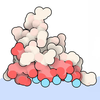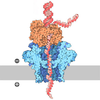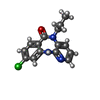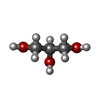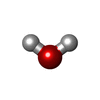[English] 日本語
 Yorodumi
Yorodumi- PDB-9iud: High resolution structure of Lectin-Like ox-LDL Receptor 1 with B... -
+ Open data
Open data
- Basic information
Basic information
| Entry | Database: PDB / ID: 9iud | ||||||
|---|---|---|---|---|---|---|---|
| Title | High resolution structure of Lectin-Like ox-LDL Receptor 1 with BI-0115 in space group P 21 21 21 | ||||||
 Components Components | Oxidized low-density lipoprotein receptor 1 | ||||||
 Keywords Keywords | LIPID BINDING PROTEIN / inhibitor / complex | ||||||
| Function / homology |  Function and homology information Function and homology informationlow-density lipoprotein particle receptor activity / lipoprotein metabolic process / blood circulation / leukocyte cell-cell adhesion / tertiary granule membrane / immune system process / specific granule membrane / Cell surface interactions at the vascular wall / carbohydrate binding / receptor complex ...low-density lipoprotein particle receptor activity / lipoprotein metabolic process / blood circulation / leukocyte cell-cell adhesion / tertiary granule membrane / immune system process / specific granule membrane / Cell surface interactions at the vascular wall / carbohydrate binding / receptor complex / membrane raft / inflammatory response / intracellular membrane-bounded organelle / Neutrophil degranulation / proteolysis / extracellular region / nucleoplasm / identical protein binding / membrane / plasma membrane Similarity search - Function | ||||||
| Biological species |  Homo sapiens (human) Homo sapiens (human) | ||||||
| Method |  X-RAY DIFFRACTION / X-RAY DIFFRACTION /  SYNCHROTRON / SYNCHROTRON /  MOLECULAR REPLACEMENT / Resolution: 1.98 Å MOLECULAR REPLACEMENT / Resolution: 1.98 Å | ||||||
 Authors Authors | Khan, M.A. / Arulandu, A. | ||||||
| Funding support |  India, 1items India, 1items
| ||||||
 Citation Citation |  Journal: To Be Published Journal: To Be PublishedTitle: High resolution structure of Lectin-Like ox-LDL Receptor 1 with BI-0115 in space group P 21 21 21 Authors: khan, M.A. / Arulandu, A. | ||||||
| History |
|
- Structure visualization
Structure visualization
| Structure viewer | Molecule:  Molmil Molmil Jmol/JSmol Jmol/JSmol |
|---|
- Downloads & links
Downloads & links
- Download
Download
| PDBx/mmCIF format |  9iud.cif.gz 9iud.cif.gz | 234.9 KB | Display |  PDBx/mmCIF format PDBx/mmCIF format |
|---|---|---|---|---|
| PDB format |  pdb9iud.ent.gz pdb9iud.ent.gz | Display |  PDB format PDB format | |
| PDBx/mmJSON format |  9iud.json.gz 9iud.json.gz | Tree view |  PDBx/mmJSON format PDBx/mmJSON format | |
| Others |  Other downloads Other downloads |
-Validation report
| Summary document |  9iud_validation.pdf.gz 9iud_validation.pdf.gz | 1.6 MB | Display |  wwPDB validaton report wwPDB validaton report |
|---|---|---|---|---|
| Full document |  9iud_full_validation.pdf.gz 9iud_full_validation.pdf.gz | 1.6 MB | Display | |
| Data in XML |  9iud_validation.xml.gz 9iud_validation.xml.gz | 56.3 KB | Display | |
| Data in CIF |  9iud_validation.cif.gz 9iud_validation.cif.gz | 74 KB | Display | |
| Arichive directory |  https://data.pdbj.org/pub/pdb/validation_reports/iu/9iud https://data.pdbj.org/pub/pdb/validation_reports/iu/9iud ftp://data.pdbj.org/pub/pdb/validation_reports/iu/9iud ftp://data.pdbj.org/pub/pdb/validation_reports/iu/9iud | HTTPS FTP |
-Related structure data
| Similar structure data | Similarity search - Function & homology  F&H Search F&H Search |
|---|
- Links
Links
- Assembly
Assembly
| Deposited unit | 
| ||||||||
|---|---|---|---|---|---|---|---|---|---|
| 1 | 
| ||||||||
| 2 | 
| ||||||||
| Unit cell |
|
- Components
Components
| #1: Protein | Mass: 15668.785 Da / Num. of mol.: 8 Source method: isolated from a genetically manipulated source Source: (gene. exp.)  Homo sapiens (human) / Gene: OLR1, CLEC8A, LOX1 / Production host: Homo sapiens (human) / Gene: OLR1, CLEC8A, LOX1 / Production host:  #2: Chemical | ChemComp-NJT / #3: Chemical | ChemComp-GOL / #4: Water | ChemComp-HOH / | Has ligand of interest | Y | Has protein modification | Y | |
|---|
-Experimental details
-Experiment
| Experiment | Method:  X-RAY DIFFRACTION / Number of used crystals: 1 X-RAY DIFFRACTION / Number of used crystals: 1 |
|---|
- Sample preparation
Sample preparation
| Crystal | Density Matthews: 2.22 Å3/Da / Density % sol: 44.6 % |
|---|---|
| Crystal grow | Temperature: 293.15 K / Method: vapor diffusion, sitting drop Details: 0.2 M Magnesium formate dihydrate, 20 % w/v PEG 3350 |
-Data collection
| Diffraction | Mean temperature: 100 K / Serial crystal experiment: N | ||||||||||||||||||||||||
|---|---|---|---|---|---|---|---|---|---|---|---|---|---|---|---|---|---|---|---|---|---|---|---|---|---|
| Diffraction source | Source:  SYNCHROTRON / Site: SYNCHROTRON / Site:  ELETTRA ELETTRA  / Beamline: 11.2C / Wavelength: 1 Å / Beamline: 11.2C / Wavelength: 1 Å | ||||||||||||||||||||||||
| Detector | Type: DECTRIS PILATUS 6M / Detector: PIXEL / Date: May 12, 2022 | ||||||||||||||||||||||||
| Radiation | Protocol: SINGLE WAVELENGTH / Monochromatic (M) / Laue (L): M / Scattering type: x-ray | ||||||||||||||||||||||||
| Radiation wavelength | Wavelength: 1 Å / Relative weight: 1 | ||||||||||||||||||||||||
| Reflection | Resolution: 1.97→80.25 Å / Num. obs: 71550 / % possible obs: 94.9 % / Redundancy: 9.6 % / CC1/2: 0.997 / Rmerge(I) obs: 0.121 / Rpim(I) all: 0.041 / Rrim(I) all: 0.128 / Net I/σ(I): 11.3 | ||||||||||||||||||||||||
| Reflection shell | Diffraction-ID: 1
|
- Processing
Processing
| Software |
| |||||||||||||||||||||||||||||||||||||||||||||||||||||||||||||||||||||||||||||||||||||||||||||||||||||||||||||||||||||||||||||||||||||||||||||||||||||||||||||||||||||||||||||||||||||||||||||
|---|---|---|---|---|---|---|---|---|---|---|---|---|---|---|---|---|---|---|---|---|---|---|---|---|---|---|---|---|---|---|---|---|---|---|---|---|---|---|---|---|---|---|---|---|---|---|---|---|---|---|---|---|---|---|---|---|---|---|---|---|---|---|---|---|---|---|---|---|---|---|---|---|---|---|---|---|---|---|---|---|---|---|---|---|---|---|---|---|---|---|---|---|---|---|---|---|---|---|---|---|---|---|---|---|---|---|---|---|---|---|---|---|---|---|---|---|---|---|---|---|---|---|---|---|---|---|---|---|---|---|---|---|---|---|---|---|---|---|---|---|---|---|---|---|---|---|---|---|---|---|---|---|---|---|---|---|---|---|---|---|---|---|---|---|---|---|---|---|---|---|---|---|---|---|---|---|---|---|---|---|---|---|---|---|---|---|---|---|---|---|
| Refinement | Method to determine structure:  MOLECULAR REPLACEMENT / Resolution: 1.98→41.27 Å / SU ML: 0.24 / Cross valid method: THROUGHOUT / σ(F): 1.34 / Phase error: 29.74 / Stereochemistry target values: ML MOLECULAR REPLACEMENT / Resolution: 1.98→41.27 Å / SU ML: 0.24 / Cross valid method: THROUGHOUT / σ(F): 1.34 / Phase error: 29.74 / Stereochemistry target values: ML
| |||||||||||||||||||||||||||||||||||||||||||||||||||||||||||||||||||||||||||||||||||||||||||||||||||||||||||||||||||||||||||||||||||||||||||||||||||||||||||||||||||||||||||||||||||||||||||||
| Solvent computation | Ion probe radii: 0.7 Å / Shrinkage radii: 0.9 Å / VDW probe radii: 1.11 Å / Solvent model: FLAT BULK SOLVENT MODEL | |||||||||||||||||||||||||||||||||||||||||||||||||||||||||||||||||||||||||||||||||||||||||||||||||||||||||||||||||||||||||||||||||||||||||||||||||||||||||||||||||||||||||||||||||||||||||||||
| Displacement parameters | Biso mean: 33 Å2 | |||||||||||||||||||||||||||||||||||||||||||||||||||||||||||||||||||||||||||||||||||||||||||||||||||||||||||||||||||||||||||||||||||||||||||||||||||||||||||||||||||||||||||||||||||||||||||||
| Refinement step | Cycle: LAST / Resolution: 1.98→41.27 Å
| |||||||||||||||||||||||||||||||||||||||||||||||||||||||||||||||||||||||||||||||||||||||||||||||||||||||||||||||||||||||||||||||||||||||||||||||||||||||||||||||||||||||||||||||||||||||||||||
| Refine LS restraints |
| |||||||||||||||||||||||||||||||||||||||||||||||||||||||||||||||||||||||||||||||||||||||||||||||||||||||||||||||||||||||||||||||||||||||||||||||||||||||||||||||||||||||||||||||||||||||||||||
| LS refinement shell |
|
 Movie
Movie Controller
Controller


 PDBj
PDBj